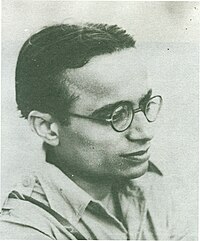Hasmukh Dhirajlal Sankalia
| Hasmukh Dhirajlal Sankalia | |
|---|---|

H.D. Sankalia
|
|
| Born |
10 December 1908 Mumbai, India |
| Died | 28 January 1989 (aged 80) Pune, India |
| Nationality | Indian |
| Fields | Archaeologist |
| Alma mater |
University of Bombay London University |
| Known for | Prehistoric Discoveries in India |
Hasmukh Dhirajlal Sankalia (હસમુખ ધીરજલાલ સાંકળિયા) (10 December 1908 - 28 January 1989) was an Indian archaeologist, specialising in Proto- and Ancient Indian history. He is considered to have pioneered archaeological excavation techniques in India, with several significant discoveries from the Prehistoric period to his credit. He was awarded Ranjitram Suvarna Chandrak in 1966.
Sankalia was born in Mumbai into a family of lawyers hailing from Gujarat. As a frail infant, the doctor did not expect him to survive long.
At the age of fifteen, he read the Gujarati translation of Lokmanya Tilak’s The Arctic Home in the Vedas. Though he did not understand much of it, as he said it himself (p. 6), he was determined to ‘do something to know about the Aryans in India’ (ibid.). He therefore decided to opt for Sanskrit and Mathematics for his B.A. because these were the subjects sound knowledge of which was a must for one who wanted to trace the origin of the Aryans (Tilak himself was a great Sanskritist and a Mathematician). This was a turning point Sankalia’s life. In B.A. he opted for Sanskrit. By that time, he had already acquired a sound knowledge of Sanskrit, and bagged the Chimanlal Ranglal Prize for scoring highest marks in that subject in Matriculation. Later on, though he was occupied more with Prehistory, his ‘life work’, the problem of the Aryans was never lost sight of: his ingenious interpretation of the Chalcolithic cultures of Rajasthan and Central India to be of an Aryan origin was largely influenced by his background. He always considered the Aryan Problem as of prime importance (1962c: 125; 1963a: 279-281; 1974: 553-559; 1978a: 79, etc.). He opted, determined as he was, for Sanskrit and voluntary English for B.A.; the latter subject introduced him to textual criticism (p. 7), which again was a powerful tool to interpret the original texts in a critical way. With the sound knowledge of Sanskrit and textual criticism, he could write an excellent article on ‘Kundamala and Uttararamacarita’, in which he convincingly proved that Dinnaga, the author of the former, influenced the author of the latter. A Bengali scholar, K. K. Dutt, arrived at similar conclusion, quite independently of Sankalia. It was in the light of the latter that Sankalia published a revised edition of his earlier paper (1966a).
...
Wikipedia
